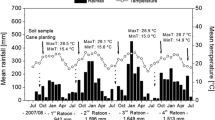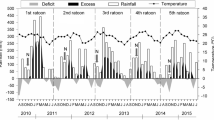Summary
Sugarcane has been grown extensively in Brasil for more than 50 years, and in the northeast from the time Brasil was discovered. Use of N-fertilizer started in the 1940's with applications of sodium nitrate, and little yield improvement was obtained in most cases. Average yield is around 70 t ha−1 yr−1 (4-harvest mean), with the first harvest 1.5 year from planting and a ratoon harvest each year thereafter. Nitrogen responses are obtained only with ratoon crops. Nitrogen inputs to the plant come from native soil-N, fertilizer-N, and biological fixation. Sources of loss include N-leaching from leaves and decomposing roots and loss of stems and leaves at harvest. There are technical and economic problems with returning factory waste (vinhoto) to the fields as fertilizer. A reasonably conservative estimate of biological nitrogen fixation holds that 17% of total plant nitrogen is fixed by the plant, or 16.6 kg N ha−1 for a harvest of 70×103 kg ha−1. Rotation and intercropping of legumes with sugarcane could increase N2-fixation by 35 kg N ha−1 yr−1 (soybean rotation) and 25 kg N ha−1 yr−1 (Phaseolus beans intercropping).
Resumen
La caña de azucar se cultiva extensamente en Brasil desde hace mas de cincuenta años y en el noreste del pais desde la época del descubrimiento. El uso del fertilizante nitrogenado empezó en 1940 con aplicaciones de nitrato de sodio que resultaban en poco aumento de los rendimientos en general. El rendimiento promedio actual es de 70×103 kg ha−1 año−1 (promedio de cuatro cosechas); se realiza la primera cosecha al año y medio de la siembra y en los años sucesivos se cosecha la soca. Se obtienen respuestas positivas a la fertilización nitrogenada solamente en estas últimas cosechas de socas. Las entradas de nitrógeno a la planta provienen del nitrógeno nativo del suelo, el añadido por fertilizante y por fijación biológica. Las pérdidas incluyen la lixiviación de nitrógeno de las hojas y por decomposición de raices y la exportación de hojas y tallos por cosecha. El retorno de los residuos de la fábrica al campo presenta aun ciertos problemas técnicos y económicos. La fijación biológica de nitrógeno puede ser razonablemente estimada asumiendo que el 17% del nitrógeno total de la planta proviene de esta fuente; o sea unos 16,6 kg N ha−1 para una cosecha de 70×103 kg ha−1. Los cultivos de leguminosas intercalados o en rotación con la caña de azucar podrían elevar la fijación biológica de nitrógeno hasta valores de 35 kg N ha−1 año−1 (rotación con soya) o 25 kg N ha−1 año−1 (cultivo intrecalado de frijol, Phaseolus).
Similar content being viewed by others
References
Alejo N O 1980 Efeito do Nitrogênio Nítrico, Ammonical e de Uréia Sobre o Crescimento, Carbohidrato e Compostos Nitrogenados em Cana-de-Açúcar (Saccharum spp. v. NA 56–79) Cultivada em Solução Nutritiva-M.S. Dissertação Piracicaba, S.P. Brasil: ESALQ.
Cervellini A, Ruschel A P, Victória R L and Reichardt K 1980 Fate of15N applied as ammonium sulphate to bean crop.In Soil Nitrogen as Fertilizer or Pollutant, IAEA Panel-Proceedings Series STI/PUB/535, pp 23–36. Vienna: IAEA.
Graciolli L A and Ruschel A P 1981 Microorganisms in the phyllosphere and rhizosphere of sugarcane.In Vose P B and Ruschel A P (Eds.). Associative N2-fixation. Vol. II. pp 91–101. Boca Raton, Florida: CRC Press.
Gutiérrez D J B 1981 Inoculation conRhizobium japonicum en soya (Glycine max L.) Merril, intercalada a caña-de-azucar (Saccharum officinarum L.) en el Valle del Cauca-Colombia.In Vose P B and Ruschel A P (Eds.). Associative N2-fixation. Vol. II. pp 169–175. Boca Raton, Florida: CRC Press.
Kohl D H, Shere C B and Commover B 1971 Fertilizer nitrogen: contribution to nitrate in surface water in corn belt watershed. Science 174, 1331.
Libardi P L, Victória R I, Reichardt K and Cervellini A 1982 Nitrogen cycling in a15N-fertilized tropical bean (Phaseolus vulgaris L.) crop.In Robertson G P, Herrera R and Rosswall T (Eds.). Nitrogen Cycling in Ecosystems of Latin American and Caribbean. Plant and Soil 67, 193–208.
Malavolta E, Haag H P, Mell F A F and Brasil Sobro M D C (Eds.) 1974 Nutrição mineral de plantas cultivadas. Nutrição mineral e adubacção de cana-de-açúcar, pp 259–292. São Paulo, Brazil: Bivraria Pioneira Editora.
Patriquin D G, Graciolli L A and Ruschel A P 1980 Nitrogenase activity of sugarcane propagated from stem cutting in sterile vermiculite. Soil Biol. Biochem. 12, 413–417.
Purchase B S 1980 Nitrogen fixation associated with sugarcane.In Collingwood, D (Ed.). Proceedings of the South African Sugar Technologists Association, pp 173–176. Natal, South Africa: SASTA.
Rennie D A and Paul E A 1974 Nitrogen isotope ratios in surface and sub-surface soil horizons.In Proceedings of Symposium on Isotope Ratios as Indicators of Pollutant Sources and Behaviour Indicators. IAEA Publ. No. SM-191/31, pp 441–453. Vienna: IAEA.
Ruschel A P 1980 As alternativas energéticas na agricultura tropical brasileira. Energia 2, 31–34.
Ruschel A P and Ruschel R 1978 Varietal differences affecting nitrogenase activity in the rhizosphere of sugarcane.In Reis, F S and Dick J (Eds.). Proc XVI Congress International Society of Sugarcane Technologists 2, 1941–1948.
Ruschel A P and Vose P B 1977 Present situation concerning studies in associative N-fixation sugarcane,Saccharum officinarum L., Boletim Científico 045. Piracicaba, São Paulo, Brazil: CENA. 28 p.
Ruschel A P and Vose P B 1980 Nitrogen fixation as a source of energy in tropical agriculture.In Areus PL (Ed.) FAO/SIDA Workshop on Organic Recycling in Agriculture, San Jose, Costa Rica. Rome: FAO (In press).
Ruschel A P, Henis Y and Salatai E 1975 Nitrogen-15 tracing of N-fixation with soil-grown sugarcane seedlings. Soil Biol. Biochem. 7, 181–182.
Ruschel A P, Orlando F V and Zambello Jr E 1978 The effect of nitrogen, phosphorus and potassium fertilization and irrigation on nitrogenase activity and yield of sugarcane.In Reis F S and Dick J (Eds.). Proc. XVI Congress International Society of Sugarcane Technologists 2, 1903–1912.
Ruschel A P, Victória R L, Salati E and Henis Y 1978 Nitrogen fixation in sugarcane (Saccharum officinarum L.).In Granhall U (Ed.). Environmental Role of Nitrogen-Fixing Blue-Green Algae and Asymbiotic Bacteria. Ecol. Bull. Stockholm 26, 297–303.
Vose P B 1980 Introduction to Nuclear Techniques in Agronomy and Plant Biology. London: Pergamon International Library.
Vose P B, Ruschel A P and Salati E 1978 Determination of N2-fixation especially in relation to the employment of nitrogen-15 and of natural variation.In Abstracts. XXVI Congresso Nacional de Botânica, pp 89–90. Brasília, D.F. Univ. Brasilia.
Vose P B, Ruschel A P, Victória R L and Matsui E 1981 Potential N2-fixation by sugarcane (Saccharum sp.) in solution culture. I. Effect of ammoniumvs NO3 − variety and nitrogen level.In Vose P B and Ruschel A P (Eds.). Associative N2-fixation. Vol. II. pp 119–125. Boca Raton, Florida: CRC Press.
Author information
Authors and Affiliations
Rights and permissions
About this article
Cite this article
Puppin Ruschel, A., Vose, P.B. Nitrogen cycling in sugarcane. Plant Soil 67, 139–146 (1982). https://doi.org/10.1007/BF02182762
Issue Date:
DOI: https://doi.org/10.1007/BF02182762




